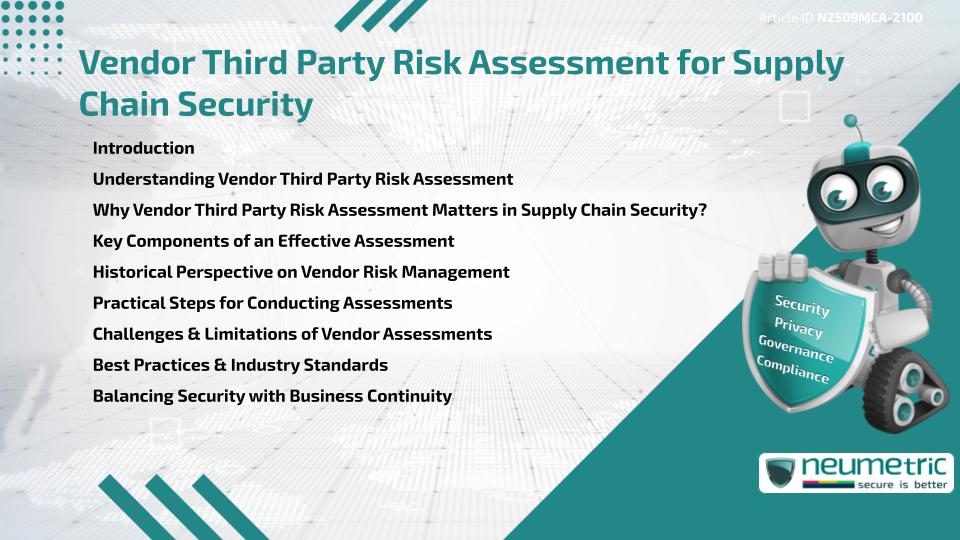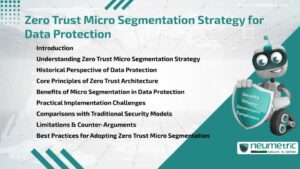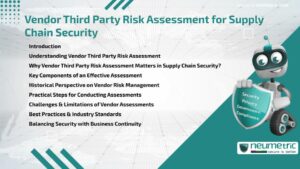Table of Contents
ToggleIntroduction
Vendor Third Party Risk Assessment is a structured process that helps Organisations evaluate the Risks associated with external Suppliers & Partners in their supply chains. It plays a critical role in preventing disruptions, maintaining Compliance & protecting Sensitive Information. In an interconnected business environment, companies rely heavily on Vendors for goods, services & technology, making it essential to identify potential Vulnerabilities. By conducting a thorough Vendor Third Party Risk Assessment, Organisations can reduce exposure to cyberattacks, fraud, regulatory penalties & operational breakdowns while building resilient supply chains.
Understanding Vendor Third Party Risk Assessment
A Vendor Third Party Risk Assessment examines how external Vendors may impact an Organisation’s Security, Compliance & Operational stability. It evaluates a supplier’s Financial health, Cybersecurity practices, regulatory adherence & overall reliability. Much like a background check before hiring an Employee, these assessments ensure that Vendors align with an organisation’s standards & values.
The process usually includes Questionnaires, Audits, On-site Inspections & Performance Monitoring. Each stage helps determine whether the Vendor poses low, medium or high Risk to the supply chain.
Why Vendor Third Party Risk Assessment Matters in Supply Chain Security?
Supply chains are only as strong as their weakest link. A single compromised Vendor can create ripple effects across industries. For example, inadequate Cybersecurity at one supplier can open doors for data breaches affecting multiple businesses.
Organisations that perform Vendor Third Party Risk Assessment gain:
- Greater visibility into potential Vulnerabilities
- Improved Compliance with Industry Standards such as ISO 27001 & SOC 2
- Protection against reputational damage
- Stronger business resilience during disruptions
Without this Assessment, businesses Risk Financial loss, regulatory action & long-term brand damage.
Key Components of an Effective Assessment
An effective Vendor Third Party Risk Assessment should include:
- Risk categorisation: Classify Vendors based on their importance & the sensitivity of the data or services they handle.
- Cybersecurity evaluation: Review the Vendor’s Security Policies, Encryption methods & Incident Response plans.
- Compliance check: Verify adherence to laws such as GDPR or HIPAA.
- Financial review: Ensure the Vendor is financially stable to meet contractual obligations.
- Continuous Monitoring: Regularly reassess Vendors instead of treating the process as a one-time activity.
This layered approach ensures that Risks are managed holistically rather than reactively.
Historical Perspective on Vendor Risk Management
Vendor management is not new. Historically, businesses relied on Contracts & Trust to ensure Vendor reliability. Over time, especially with the rise of globalisation & digital supply chains, the Risks multiplied. Events like natural disasters, geopolitical conflicts & large-scale cyberattacks have emphasised the need for formal assessments.
Today, regulatory bodies & industry frameworks require Organisations to demonstrate due diligence in Vendor management. This historical shift reflects the growing recognition that third parties are both assets & potential liabilities.
Practical Steps for Conducting Assessments
Organisations can follow these steps to conduct Vendor Third Party Risk Assessment:
- Identify critical Vendors in the supply chain.
- Use standardised Questionnaires to collect Risk-related data.
- Perform on-site visits or request Audit reports.
- Compare findings with Internal Risk tolerance levels.
- Implement Risk Mitigation strategies such as contractual safeguards.
- Continuously monitor Vendor Performance & Compliance.
This structured workflow helps businesses address Risks proactively.
Challenges & Limitations of Vendor Assessments
While Vendor Third Party Risk Assessment is valuable, it is not without limitations. Vendors may be reluctant to share Sensitive Information. Small suppliers might lack formal Risk Management processes. Additionally, the Assessment process can be resource-intensive & time-consuming.
Another challenge lies in over-reliance on self-reported data, which may not always be accurate. Organisations must balance thoroughness with practicality to avoid slowing down operations.
Best Practices & Industry Standards
To improve Vendor assessments, Organisations should:
- Adopt recognised frameworks such as NIST Cybersecurity Framework
- Automate parts of the Assessment using digital platforms
- Establish clear communication channels with Vendors
- Train internal teams on Risk awareness & Assessment methodologies
Following Best Practices helps Organisations standardise evaluations & avoid inconsistencies.
Balancing Security with Business Continuity
An effective Vendor Third Party Risk Assessment should not stifle collaboration. Instead, it should strike a balance between enforcing security requirements & supporting long-term partnerships. Transparent communication & fair evaluation foster trust while reducing Risks.
By embedding assessments into Vendor relationships, Organisations can create supply chains that are not only secure but also adaptable to change.
Takeaways
- Vendor Third Party Risk Assessment strengthens supply chain resilience.
- Effective assessments include Cybersecurity, Compliance, Financial & Operational checks.
- Historical lessons show why Risk Management evolved into formal processes.
- Practical challenges exist but can be mitigated with Best Practices & Automation.
- Balancing security with collaboration ensures sustainable partnerships.
FAQ
What is a Vendor Third Party Risk Assessment?
It is a process that evaluates the Risks posed by external Suppliers & Partners in an organisation’s supply chain.
How often should Vendor Risk Assessments be conducted?
They should be performed regularly, with high-Risk Vendors assessed more frequently through ongoing monitoring.
Who is responsible for Vendor Third Party Risk Assessment?
Typically, Risk Management, Procurement, Compliance & Security teams share responsibility for conducting & reviewing assessments.
What are the main Risks of not conducting Vendor assessments?
Businesses Risk data breaches, compliance failures, operational disruptions & reputational damage.
Do small Vendors need to undergo assessments too?
Yes, because even small suppliers can create significant Vulnerabilities in the supply chain.
How do assessments support compliance?
They verify that Vendors meet Regulatory Standards like GDPR, HIPAA & ISO 27001.
Can technology simplify Vendor assessments?
Yes, digital platforms & automated tools streamline questionnaires, monitoring & reporting.
Need help for Security, Privacy, Governance & VAPT?
Neumetric provides organisations the necessary help to achieve their Cybersecurity, Compliance, Governance, Privacy, Certifications & Pentesting needs.
Organisations & Businesses, specifically those which provide SaaS & AI Solutions in the Fintech, BFSI & other regulated sectors, usually need a Cybersecurity Partner for meeting & maintaining the ongoing Security & Privacy needs & requirements of their Enterprise Clients & Privacy conscious Customers.
SOC 2, ISO 27001, ISO 42001, NIST, HIPAA, HECVAT, EU GDPR are some of the Frameworks that are served by Fusion – a SaaS, multimodular, multitenant, centralised, automated, Cybersecurity & Compliance Management system.
Neumetric also provides Expert Services for technical security which covers VAPT for Web Applications, APIs, iOS & Android Mobile Apps, Security Testing for AWS & other Cloud Environments & Cloud Infrastructure & other similar scopes.
Reach out to us by Email or filling out the Contact Form…





